计算机算法导论
算法导论心得体会总结看完算法导论

算法导论心得体会总结看完算法导论算法导论是一本经典的计算机科学教材,深入浅出地介绍了算法设计与分析的基本概念和方法。
通过学习这本书,我对算法有了更深刻的理解,并且对计算机科学的其他领域也有了更全面的认识。
在完成学习之后,我总结了一些心得体会如下:1.算法的重要性算法是计算机科学的基石,它是将输入转化为输出的一系列规则和步骤的有序集合。
通过合理选择和设计算法,可以提高计算机程序的效率和性能。
算法的选择直接影响到程序的运行时间和空间复杂度,因此在实际应用中,我们需要针对具体问题选择合适的算法来解决。
2.算法的设计与分析算法导论中详细介绍了算法的设计方法和分析技巧。
其中,分治法、动态规划和贪心算法是常见的算法设计思想,它们可以解决许多复杂的问题。
在实际应用中,我们要根据问题的特点选择适应的算法设计思想,并通过数学推导和实验证明算法的正确性和效率。
3.数据结构与算法的关系数据结构是算法的基础,它为算法提供了组织和处理数据的方式。
算法导论中介绍了各种常用的数据结构,例如数组、链表、栈、队列、树、图等。
对于常见的操作,我们可以选择合适的数据结构来提高算法的效率和容错性。
4.算法的应用领域算法导论中还介绍了算法在各个领域的应用,例如图算法、字符串算法、排序算法等。
这些算法在计算机科学的研究和实践中有着广泛的应用。
通过学习这些算法,我们可以丰富自己的知识储备并解决实际的问题。
5.开阔思维和解决问题的能力在学习算法导论的过程中,我发现算法的设计和分析需要具备抽象思维、数学推理和问题解决的能力。
通过学习和实践,我的思维方式变得更加开阔和灵活,可以更好地应对复杂的问题和挑战。
总的来说,通过学习算法导论,我对算法有了更深入的了解。
同时,我也认识到算法设计与分析是计算机科学中非常重要的一部分,对于我以后的学习和研究都有着重要的意义。
我会继续学习和探索计算机科学的其他领域,不断提升自己的专业能力。
算法导论第四版
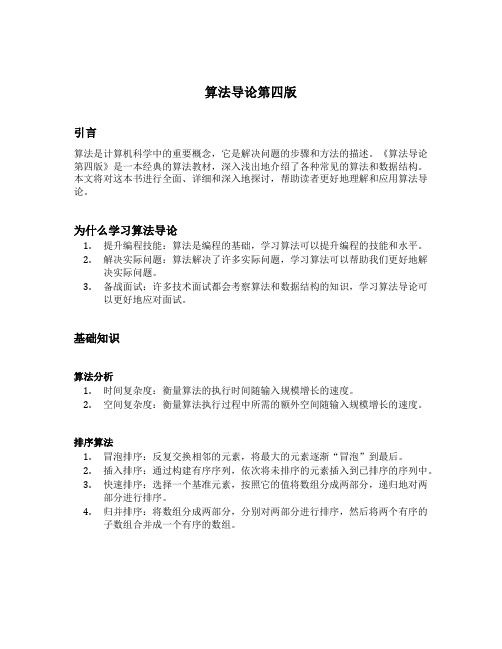
算法导论第四版引言算法是计算机科学中的重要概念,它是解决问题的步骤和方法的描述。
《算法导论第四版》是一本经典的算法教材,深入浅出地介绍了各种常见的算法和数据结构。
本文将对这本书进行全面、详细和深入地探讨,帮助读者更好地理解和应用算法导论。
为什么学习算法导论1.提升编程技能:算法是编程的基础,学习算法可以提升编程的技能和水平。
2.解决实际问题:算法解决了许多实际问题,学习算法可以帮助我们更好地解决实际问题。
3.备战面试:许多技术面试都会考察算法和数据结构的知识,学习算法导论可以更好地应对面试。
基础知识算法分析1.时间复杂度:衡量算法的执行时间随输入规模增长的速度。
2.空间复杂度:衡量算法执行过程中所需的额外空间随输入规模增长的速度。
排序算法1.冒泡排序:反复交换相邻的元素,将最大的元素逐渐“冒泡”到最后。
2.插入排序:通过构建有序序列,依次将未排序的元素插入到已排序的序列中。
3.快速排序:选择一个基准元素,按照它的值将数组分成两部分,递归地对两部分进行排序。
4.归并排序:将数组分成两部分,分别对两部分进行排序,然后将两个有序的子数组合并成一个有序的数组。
数据结构数组和链表1.数组:连续的内存空间,支持随机访问,但插入和删除的时间复杂度较高。
2.链表:不连续的内存空间,只支持顺序访问,但插入和删除的时间复杂度较低。
栈和队列1.栈:后进先出的数据结构,主要有进栈和出栈两个操作。
2.队列:先进先出的数据结构,主要有入队和出队两个操作。
哈希表1.哈希函数:将关键字映射到哈希表中的位置。
2.哈希冲突:不同的关键字映射到了同一个位置,解决冲突的方法有开放寻址法和链地址法。
3.哈希表的应用:常用于高效地插入、删除和查找操作。
树和二叉树1.树:由节点和边组成的一种数据结构,常见的树包括二叉树、平衡二叉树和B树等。
2.二叉树:每个节点最多有两个孩子节点的树。
堆和优先队列1.堆:完全二叉树,堆可以分为最大堆和最小堆。
算法导论第二版和第三版

算法导论第二版和第三版算法导论第二版和第三版是由Thomas H. Cormen、Charles E. Leiserson、Ronald L. Rivest和Clifford Stein等人合著的计算机科学教材。
本文将分别对这两个版本进行介绍和比较,旨在帮助读者了解这两本书的特点和区别。
算法导论第二版是于2001年出版的经典教材,它详细介绍了算法设计和分析的基本概念、技巧和方法。
本书共分为四个部分,分别是基础知识、排序和顺序统计量、数据结构、高级数据结构和高级主题。
其中,基础知识部分介绍了算法设计和分析的基本原理;排序和顺序统计量部分介绍了各种排序算法和顺序统计量的计算方法;数据结构部分介绍了各种基本数据结构的实现和应用;高级数据结构和高级主题部分介绍了一些高级数据结构和算法的应用场景和实现方法。
该版本的特点是思路清晰、讲解详细,适合初学者入门。
算法导论第三版是于2009年出版的更新版本,相比于第二版,第三版在内容和结构上有所调整和扩充。
本书依然分为四个部分,但在每个部分的基础上增加了新的章节和内容。
例如,在基础知识部分新增了对随机化算法和线性规划的讲解;在排序和顺序统计量部分新增了对外部排序、线性时间排序和中位数的选择算法的介绍;在数据结构部分新增了对动态规划和贪心算法的讲解;在高级数据结构和高级主题部分新增了对B树和后缀树的介绍。
此外,第三版还增加了习题的数量和难度,以及对一些经典算法和问题的详细解答。
相比于第二版,第三版更加全面深入,适合进一步学习和研究。
算法导论第二版和第三版在内容和结构上有所区别,但都是优秀的算法教材。
对于初学者来说,可以选择第二版作为入门教材,因为它的讲解详细,思路清晰;而对于已经有一定算法基础的读者,可以选择第三版进行深入学习和研究,因为它更加全面深入,包含了更多的内容和案例。
无论选择算法导论第二版还是第三版,都能够帮助读者建立起坚实的算法基础,并掌握算法设计和分析的基本原理和方法。
算法导论适合什么人看

算法导论适合什么人看《算法导论》是计算机科学领域的一部经典教材,由Thomas H. Cormen、Charles E. Leiserson、Ronald L. Rivest和Clifford Stein 所著。
这本书深入浅出地介绍了算法设计与分析的基本原理,内容包括排序、查找、图算法、分治算法、贪婪算法、动态规划等等,以及NP完全性和近似算法等高级话题。
无论是计算机科学专业的学生还是从事计算机编程工作的程序员,都可以从《算法导论》中受益匪浅。
首先,《算法导论》适合计算机科学专业的学生。
对于计算机专业的学生来说,学习算法是学好计算机科学的基础。
《算法导论》从基础的排序和查找算法开始介绍,逐渐深入,既涵盖了算法设计的基本思想,也包括了各种经典的问题及其解决方法。
同时,书中的习题也有不同难度的挑战,对于学生提升自己的算法分析与设计能力非常有帮助。
此外,编程人员也可以从《算法导论》中受益。
对于从事计算机编程工作的人员来说,掌握高效的算法和数据结构,可以使他们在工作中减少计算资源的浪费,提高程序运行效率。
《算法导论》不仅解释了各种算法的原理和实现细节,还提供了优化和改进算法性能的方法。
程序员可以通过学习书中的内容,改善自己的编程技巧,写出更高效的程序。
总而言之,《算法导论》是一本深入浅出的计算机科学经典教材,适合计算机科学专业学生、编程人员以及对算法感兴趣的人群阅读。
无论是想要提高自己的算法分析与设计能力,还是想要改善程序运行效率,亦或是纯粹对算法有兴趣,这本书都能够满足各种需求。
读者可以通过学习《算法导论》中的内容,深入了解和掌握算法设计与分析的基本原理,从而在计算机科学的学习和工作中取得更好的成绩。
算法导论参考答案

算法导论参考答案算法导论参考答案算法导论是计算机科学领域中一本经典的教材,被广泛应用于计算机科学和工程的教学和研究中。
它涵盖了算法设计和分析的基本概念,以及各种常见算法的实现和应用。
本文将为读者提供一些算法导论中常见问题的参考答案,以帮助读者更好地理解和掌握这门课程。
1. 什么是算法?算法是一系列解决问题的步骤和规则。
它描述了如何将输入转换为输出,并在有限的时间内完成。
算法应具备正确性、可读性、健壮性和高效性等特点。
2. 如何分析算法的效率?算法的效率可以通过时间复杂度和空间复杂度来衡量。
时间复杂度表示算法执行所需的时间量级,常用的时间复杂度有O(1)、O(n)、O(logn)、O(nlogn)和O(n^2)等。
空间复杂度表示算法执行所需的额外空间量级,通常以字节为单位。
3. 什么是渐进符号?渐进符号用于表示算法的时间复杂度或空间复杂度的增长趋势。
常见的渐进符号有大O符号、Ω符号和Θ符号。
大O符号表示算法的上界,Ω符号表示算法的下界,Θ符号表示算法的平均情况。
4. 什么是分治法?分治法是一种算法设计策略,将问题分解为若干个子问题,并对子问题进行独立求解,最后将子问题的解合并得到原问题的解。
典型的分治算法有归并排序和快速排序。
5. 什么是动态规划?动态规划是一种通过将问题分解为相互重叠的子问题来求解的方法。
它通常用于求解具有重叠子问题和最优子结构性质的问题。
典型的动态规划算法有背包问题和最短路径问题。
6. 什么是贪心算法?贪心算法是一种通过每一步选择局部最优解来求解整体最优解的方法。
贪心算法通常不能保证得到全局最优解,但在某些问题上能够得到近似最优解。
典型的贪心算法有霍夫曼编码和最小生成树算法。
7. 什么是图算法?图算法是一类用于解决图结构相关问题的算法。
图由节点和边组成,节点表示对象,边表示对象之间的关系。
图算法包括图的遍历、最短路径、最小生成树和网络流等问题的求解。
8. 什么是NP完全问题?NP完全问题是一类在多项式时间内无法求解的问题。
计算机 算法

计算机算法计算机算法是解决问题的一种方法或步骤,并且在计算机科学中是非常关键的。
算法可以用来解决各种各样的问题,从简单的排序和搜索问题到复杂的图形处理和机器学习问题。
在这篇文章中,我们将介绍一些与计算机算法相关的参考内容。
1.《算法导论》(Introduction to Algorithms):这本书是计算机科学领域着名的经典教材,由Thomas H. Cormen、Charles E. Leiserson、Ronald L. Rivest和Clifford Stein共同撰写。
它详细介绍了各种基本和高级算法,包括排序、搜索、图形算法、动态规划等。
该书使用伪代码描述算法,并提供了详细的证明和分析,是学习算法的必备参考。
2.《算法(原书第4版)》(Algorithms, 4th Edition):这本由Robert Sedgewick和Kevin Wayne合著的教材是一本介绍算法和数据结构的权威教材。
它提供了对经典算法和数据结构的全面讲解,并结合了大量的示例和实践。
该书还提供了Java、Python和C++等常用编程语言的实现代码和相关资源。
3.《算法设计手册》(The Algorithm Design Manual):这本书由Steven S. Skiena撰写,是一本实用而全面的算法指南。
它涵盖了各种算法设计技术、问题建模和解决策略,并提供了大量的例子和练习。
该书还介绍了常见的算法设计和分析技巧,如贪心算法、动态规划、图算法等。
4.《算法思维》(Algorithmic Thinking):这本书由Daniel Zingaro撰写,适合初学者学习算法思维和解决问题的方法。
它介绍了基本的计算机科学概念和算法思维模式,并通过丰富的实例和练习帮助读者培养良好的算法思维能力。
5.《算法问题解决与程序设计指南》(Problem Solving with Algorithms and Data Structures using Python):这本书由Bradley N. Miller和David L. Ranum合著,旨在帮助读者学习算法、数据结构和Python编程。
算法导论习题答案

算法导论习题答案算法导论习题答案算法导论是一本经典的计算机科学教材,讲述了算法设计与分析的基本原理。
在学习过程中,习题是不可或缺的一部分,通过解答习题可以帮助我们巩固所学的知识。
本文将针对算法导论中的一些习题进行解答,帮助读者更好地理解算法导论的内容。
习题1-1:证明对于任意两个实数a和b,有|a + b| ≤ |a| + |b|。
解答:根据绝对值的定义,我们可以将|a + b|、|a|和|b|分别表示为以下三种情况:1. 当a + b ≥ 0,a ≥ 0,b ≥ 0时,|a + b| = a + b,|a| = a,|b| = b。
此时,|a + b| ≤ |a| + |b| 成立。
2. 当a + b < 0,a < 0,b < 0时,|a + b| = -(a + b),|a| = -a,|b| = -b。
此时,|a + b| ≤ |a| + |b| 成立。
3. 当a + b ≥ 0,a < 0,b < 0时,|a + b| = a + b,|a| = -a,|b| = -b。
此时,|a + b| ≤ |a| + |b| 成立。
综上所述,无论a和b的取值如何,都有|a + b| ≤ |a| + |b| 成立。
习题2-1:证明插入排序的运行时间是O(n^2)。
解答:插入排序是一种简单直观的排序算法,它的基本思想是将待排序的元素一个个地插入到已排好序的序列中。
在最坏情况下,即待排序的序列是逆序排列时,插入排序的运行时间最长。
假设待排序的序列长度为n,那么第一次插入需要比较1次,第二次插入需要比较2次,依次类推,第n次插入需要比较n-1次。
总的比较次数为1 + 2 + 3+ ... + (n-1) = n(n-1)/2。
因此,插入排序的运行时间是O(n^2)。
习题3-1:证明选择排序的运行时间是O(n^2)。
解答:选择排序是一种简单直观的排序算法,它的基本思想是每次从待排序的序列中选择最小的元素,放到已排序序列的末尾。
算法导论答案

算法导论答案算法导论是计算机科学领域的经典教材,它介绍了算法设计和分析的基本原理和方法。
通过学习算法导论,我们可以深入理解算法的运行机制,并且能够运用这些知识解决实际问题。
本文将介绍一些算法导论的常见问题,并给出相应的答案。
第一部分:算法基础在算法导论中,我们首先学习了算法的基础概念和表达方法。
其中最重要的是时间复杂度和空间复杂度的概念。
时间复杂度衡量了算法运行所需的时间,而空间复杂度则衡量了算法所需要的额外空间。
通过计算复杂度,我们可以估算出算法的效率和资源使用情况。
Q1:什么是时间复杂度和空间复杂度?A1:时间复杂度是指算法解决问题所需要的时间代价,通常以大O表示。
空间复杂度是指算法解决问题所需要的额外空间,通常也以大O表示。
时间复杂度和空间复杂度可以帮助我们评估算法的效率和资源使用情况。
Q2:如何计算时间复杂度?A2:时间复杂度可以通过分析算法中的基本操作的执行次数来计算。
通常,我们可以统计算法中循环、递归和条件判断等操作的执行次数,并根据问题规模n来表示。
然后,我们可以将执行次数与n的关系用大O表示法表示。
第二部分:排序算法算法导论中介绍了多种排序算法,包括插入排序、归并排序、快速排序等等。
不同的排序算法适用于不同的问题场景,并且它们的时间复杂度和稳定性也不同。
Q3:什么是稳定的排序算法?A3:稳定的排序算法是指当原始序列中有两个相等的元素时,排序后它们的相对位置不发生改变。
例如,插入排序和归并排序是稳定的排序算法,而快速排序不是稳定的排序算法。
Q4:如何选择合适的排序算法?A4:选择合适的排序算法需要考虑多个因素,包括数据规模、稳定性要求和系统资源等。
对于小规模数据,可以使用插入排序或者冒泡排序。
对于数据规模较大且对稳定性要求较高的情况,可以选择归并排序。
而快速排序则适用于大规模数据和对稳定性没有要求的场景。
第三部分:动态规划动态规划是算法导论中的重要主题,它是一种解决多阶段决策问题的方法。
算法导论pdf

算法导论pdf本书可作为计算机、信息技术等相关专业的本科生和研究生的教材,也可供广大计算机爱好者自学参考。
本书将算法定义为“一个有穷的、能被满足的需求(问题)求解方案”,将算法描述成“一组前后相连、互不重复的步骤”,即算法是能够表示某种输入——输出关系(数据结构)的运算或操作序列。
并将算法划分为数值算法、图形算法、逻辑算法、时间计算算法等类别。
本书包括四部分内容:绪论、数值算法、图形算法和逻辑算法。
每部分又按照算法基本理论、典型算法、数值算法实现三个层次进行介绍。
算法的分类从算法所属学科来看: 1。
算法属于计算机科学的研究领域,主要研究如何用计算机解决数学或其他学科的问题; 2。
算法属于数学科学的研究领域,主要研究数学模型与求解数学问题的算法; 3。
算法属于自动控制科学的研究领域,主要研究计算机在控制过程中的具体应用,即用计算机来模拟人的思维活动; 4。
算法属于信息科学的研究领域,主要研究对有关客观事物的内在规律的总结和抽象,即算法是一种模式。
由此可见,算法可以看作是反映客观世界内在联系的数学模型,这种联系有时间上的顺序性,也有空间上的顺序性,还有时间、空间顺序性的交叉性。
2。
算法实现:算法的实现是把计算机中的指令通过硬件执行。
因此实现算法的基础就是一种计算机语言——编译程序。
而具有较强的计算功能的数字计算机叫做计算机,所以,要掌握好算法,必须先了解计算机,然后再把它应用到具体的问题上去。
3。
算法设计:算法设计又称为算法描述,是用适当的数学模型描述算法的语言,它将算法分析、设计、实施直至优化的全过程贯穿起来。
3。
数值算法4。
存储结构。
我们在使用算法进行计算时,往往是从两方面来考虑的:一是使算法本身具有良好的适应性和通用性,即适合各种不同问题的解法。
二是算法的执行效率,也就是算法本身的速度。
一般情况下,计算机硬件实现的算法都比较慢,所以如果希望提高算法的速度,首先应该选择高速计算机,其次要加快程序的编写速度,第三要提高运算器和存储器的速度,再次要提高输入/输出的速度。
算法导论和数据结构区别?

《算法导论》和《数据结构》是计算机科学中两本经典的教材,它们涉及的内容有一定的重叠,但也存在一些区别。
1. 内容范围:《算法导论》主要关注算法设计和分析的基本原理,包括算法基础、排序和选择算法、图算法、动态规划等等。
它涵盖了算法的各个方面,从算法的设计思想到性能分析等方面进行了深入讲解。
而《数据结构》则更专注于数据的组织、存储和操作方式,包括线性表、树、图、堆、散列表等常见数据结构的理论与实现。
2. 视角角度:《算法导论》以算法为中心,强调算法的设计思想、效率分析和应用。
它侧重于研究如何解决实际问题的高效算法。
而《数据结构》则以数据结构为中心,侧重于研究如何组织和管理数据,以实现高效的数据操作和算法执行。
3. 算法与数据结构关系:《算法导论》介绍了各种算法的设计和分析方法,但很多算法的实现需要依赖合适的数据结构。
因此,在学习《算法导论》的过程中,理解和应用各种数据结构是必要的。
《数据结构》则更多地关注数据的组织和操作方式,但也会涉及一些常用算法的应用,因为很多算法的效率与所使用的数据结构密切相关。
综上所述,《算法导论》和《数据结构》在内容范围、视角角度和侧重点上存在一定的差异。
理解和掌握这两个领域的知识对于计算机科学的学习和实践都至关重要,它们相互补充,共同构建了计算机科学的基础。
算法导论必备知识
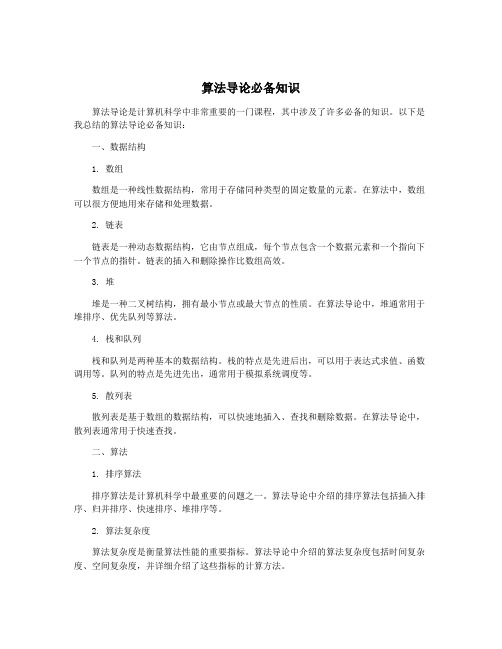
算法导论必备知识算法导论是计算机科学中非常重要的一门课程,其中涉及了许多必备的知识。
以下是我总结的算法导论必备知识:一、数据结构1. 数组数组是一种线性数据结构,常用于存储同种类型的固定数量的元素。
在算法中,数组可以很方便地用来存储和处理数据。
2. 链表链表是一种动态数据结构,它由节点组成,每个节点包含一个数据元素和一个指向下一个节点的指针。
链表的插入和删除操作比数组高效。
3. 堆堆是一种二叉树结构,拥有最小节点或最大节点的性质。
在算法导论中,堆通常用于堆排序、优先队列等算法。
4. 栈和队列栈和队列是两种基本的数据结构。
栈的特点是先进后出,可以用于表达式求值、函数调用等。
队列的特点是先进先出,通常用于模拟系统调度等。
5. 散列表散列表是基于数组的数据结构,可以快速地插入、查找和删除数据。
在算法导论中,散列表通常用于快速查找。
二、算法1. 排序算法排序算法是计算机科学中最重要的问题之一。
算法导论中介绍的排序算法包括插入排序、归并排序、快速排序、堆排序等。
2. 算法复杂度算法复杂度是衡量算法性能的重要指标。
算法导论中介绍的算法复杂度包括时间复杂度、空间复杂度,并详细介绍了这些指标的计算方法。
3. 动态规划算法动态规划算法是一种计算机算法,通常用于解决多阶段决策问题。
在算法导论中,介绍了动态规划算法的原理和应用。
4. 贪心算法三、数学知识离散数学是计算机科学的基础,是学习算法导论的必备知识。
离散数学包括集合论、图论、数论、代数等内容。
2. 概率论概率论是计算机科学中被广泛应用的数学分支。
在算法导论中,介绍了概率分析算法的相关知识。
以上就是我总结的算法导论必备知识。
如果想深入学习算法导论,这些知识是必不可少的。
计算机算法导论 第9章
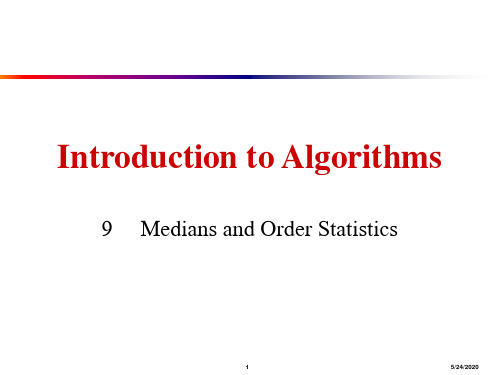
≥ A[q] r
9/26/2010
Randomized Selection
● Analyzing RandomizedSelect()
■ Worst case: partition always 0:n-1 T(n) = T(n-1) + O(n) = ??? = O(n2) (arithmetic series) ○ No better than sorting! ■ “Best” case: suppose a 9:1 partition T(n) = T(9n/10) + O(n) = ??? = O(n) (Master Theorem, case 3) ○ Better than sorting! ○ What if this had been a 99:1 split?
11 9/26/2010
Randomized Selection
12
9/26/2010
Randomized Selection
13
9/26/2010
Calculating expectation
14
9/26/2010
Calculating expectation
15
9/26/2010
Calculating expectation
21
9/26/2010
Summary of randomized order-statistic selection Works fast: linear expected time. Excellent algorithm in practice. But, the worst case is very bad: Θ(n2).
■ A practical randomized algorithm with O(n)
算法导论第十五章习题答案

算法导论第十五章习题答案算法导论第十五章习题答案算法导论是一本经典的计算机科学教材,其中第十五章涵盖了图算法的内容。
本文将针对该章节中的习题进行解答,并对其中一些问题进行深入探讨。
1. 习题15.1-1题目要求证明:对于任意的有向图G=(V,E),如果图中不存在从节点u到节点v的路径,则在每个强连通分量中,节点u和节点v都在同一个强连通分量中。
证明:假设存在一个强连通分量C,其中节点u在C中,节点v在C'中(C'为除了C之外的其他强连通分量)。
由于不存在从u到v的路径,所以在C中不存在从u到v的路径。
但是根据强连通分量的定义,C中的任意两个节点之间都存在路径。
所以存在一条从v到u的路径。
这与C'中的节点v不在C中矛盾,所以假设不成立,节点u和节点v必定在同一个强连通分量中。
2. 习题15.2-2题目要求证明:在一个有向无环图中,存在一个拓扑排序,使得任意两个非根节点u和v,u在v之前。
证明:假设存在一个有向无环图G=(V,E),不存在上述所要求的拓扑排序。
即对于任意的拓扑排序,存在两个非根节点u和v,u在v之后。
那么我们可以得到一条从u到v的路径。
由于图中不存在环,所以路径上的节点不会重复。
我们可以将路径上的节点按照拓扑排序的顺序排列,得到一个新的拓扑排序,使得u在v之前。
这与假设矛盾,所以原命题成立。
3. 习题15.3-3题目要求证明:在一个有向图G=(V,E)中,如果存在一条从节点u到节点v的路径,那么在图的转置G^T中,存在一条从节点v到节点u的路径。
证明:假设存在一条从节点u到节点v的路径。
那么在图的转置G^T中,边(u,v)变成了边(v,u)。
所以存在一条从节点v到节点u的路径。
因此,原命题成立。
4. 习题15.4-1题目要求:给出一个算法,判断一个有向图G=(V,E)是否是有向无环图。
算法思路:我们可以使用深度优先搜索(DFS)来判断是否存在环。
具体步骤如下:1. 对于图中的每个节点v,设置一个状态标记visited[v]为false。
算法导论适合什么人看

算法导论适合什么人看
《算法导论》适合有一定的编程基础的计算机科学爱好者、程序员、数据科学家、软件工程师,以及有系统地学习算法的学生来阅读。
1、适合有一定的编程基础的计算机科学爱好者。
《算法导论》主要是给有一定编程基础的计算机科学爱好者准备的,涉及到数据结构、排序算法、算法复杂度分析以及图算法等内容,内容深入浅出,能够让计算机科学爱好者对算法有系统的认识。
2、程序员。
程序员也可以通过阅读《算法导论》来提高编程水平,书中涉及到常见的算法,学完后可以帮助程序员编写出高效的代码,会有明显的提高效率的效果。
3、数据科学家。
数据科学家也可以从《算法导论》中学习算法,这对他们非常有帮助,书中涉及到各种算法,能够帮助数据科学家们更好地挖掘和分析数据。
4、软件工程师
软件工程师也可以从《算法导论》中得到提升,书中讲解的算法可以帮助软件工程师们编写出高效的算法和代码,能够使得软件的性能得到有效提升。
5、有系统学习算法的学生
《算法导论》也是有系统学习算法的学生必备的书籍,学完能够帮助学生们系统地认识和掌握算法,从而能更好地把握学习内容和拓宽学习广度。
最好的计算机算法的书籍
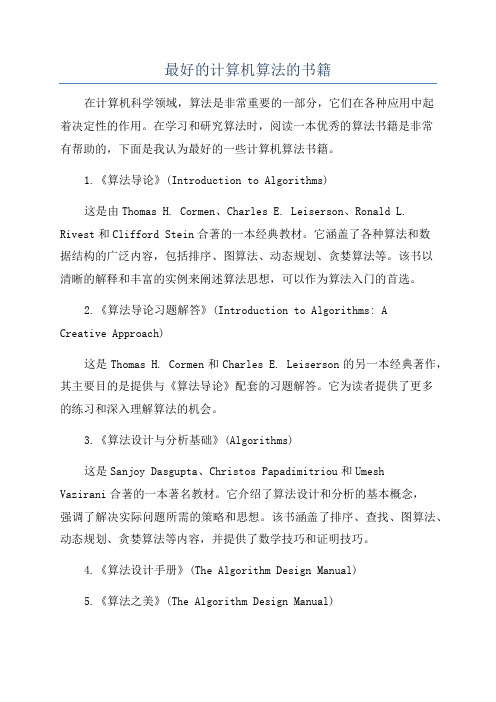
最好的计算机算法的书籍在计算机科学领域,算法是非常重要的一部分,它们在各种应用中起着决定性的作用。
在学习和研究算法时,阅读一本优秀的算法书籍是非常有帮助的,下面是我认为最好的一些计算机算法书籍。
1.《算法导论》(Introduction to Algorithms)这是由Thomas H. Cormen、Charles E. Leiserson、Ronald L. Rivest和Clifford Stein合著的一本经典教材。
它涵盖了各种算法和数据结构的广泛内容,包括排序、图算法、动态规划、贪婪算法等。
该书以清晰的解释和丰富的实例来阐述算法思想,可以作为算法入门的首选。
2.《算法导论习题解答》(Introduction to Algorithms: ACreative Approach)这是Thomas H. Cormen和Charles E. Leiserson的另一本经典著作,其主要目的是提供与《算法导论》配套的习题解答。
它为读者提供了更多的练习和深入理解算法的机会。
3.《算法设计与分析基础》(Algorithms)这是Sanjoy Dasgupta、Christos Papadimitriou和UmeshVazirani合著的一本著名教材。
它介绍了算法设计和分析的基本概念,强调了解决实际问题所需的策略和思想。
该书涵盖了排序、查找、图算法、动态规划、贪婪算法等内容,并提供了数学技巧和证明技巧。
4.《算法设计手册》(The Algorithm Design Manual)5.《算法之美》(The Algorithm Design Manual)这是Jon Kleinberg和Éva Tardos合著的一本优秀教材,它着重介绍了算法设计和分析的关键思想。
该书以生动的方式讲解了算法的应用和影响,帮助读者理解算法如何解决实际问题。
此外,该书还包含了丰富的实例和习题,帮助读者巩固所学知识。
6.《算法设计师手记》(The Algorithm Designers Manual)这是Steven S. Skiena撰写的一本实用参考手册,它提供了大量的算法实现代码和解决问题的思路。
算法导论doc
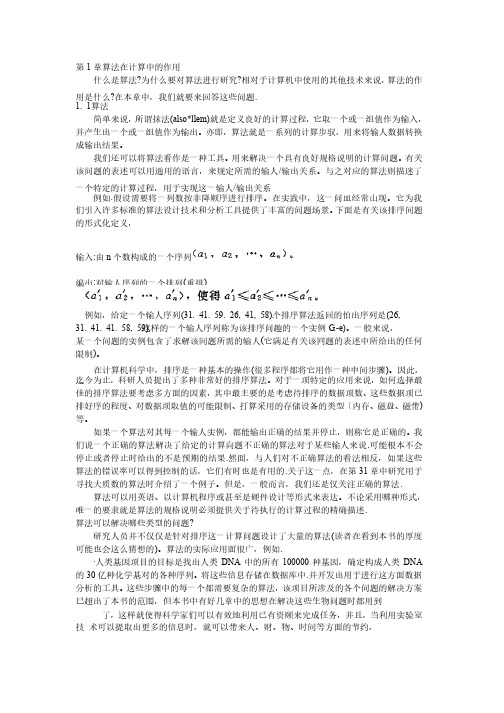
第1章算法在计算中的作用章算法在计算中的作用什么是算法?为什么要对算法进行研究?相对于计算机中使用的其他技术来说,算法的作用是什么?在本章中,我们就要来回答这些问题. 1. 1算法算法简单来说,所谓抹法(also*llem)就是定义良好的计算过程,它取一个或一组值作为输入,并产生出一个或一组值作为输出。
并产生出一个或一组值作为输出。
亦即,亦即,算法就是一系列的计算步驭,算法就是一系列的计算步驭,用来将输人数据转换用来将输人数据转换成输出结果。
成输出结果。
我们还可以将算法看作是一种工具。
用来解决一个具有良好规格说明的计算问题。
有关该问题的表述可以用通用的语言,来规定所需的输人/输出关系。
与之对应的算法则描迷了一个特定的计算过程,用于实现这一输人/输出关系输出关系例如.假设需要将一列数按非降顺序进行排序。
在实践中,这一问皿经常山现。
它为我们引入许多标准的算法设计技术和分析工具提供了丰富的问题场景。
下面是有关该排序间题的形式化定义,的形式化定义,输入:由n 个数构成的一个序列编出:对输人序列的一个排列(重排) 例如,给定一个输人序列(31. 41. 59. 26, 41, 58).一个排序算法返回的怕出序列是(26, 31. 41. 41. 58, 59).这样的一个输人序列称为该排序问趣的一个实例G .-e)。
一般来说,。
一般来说,某一个问题的实例包含了求解该间题所需的输人(它满足有关该同题的表述中所给出的任何限制)。
在计算机科学中,排序是一种基本的操作(很多程序都将它用作一种申间步骤)。
因此,迄今为止,科研人员提出了多种非常好的排序算法。
科研人员提出了多种非常好的排序算法。
对于一项特定的应用来说,对于一项特定的应用来说,对于一项特定的应用来说,如何选择最如何选择最佳的排序算法要考虑多方面的因素,其中最主要的是考虑待排序的数据项数、这些数据项已排好序的程度、对数据项取值的可能限制、对数据项取值的可能限制、打算采用的存储设备的类型打算采用的存储设备的类型〔内存、磁盘、磁带)等。
大学生算法导论心得体会

大学生算法导论心得体会《算法导论》是一本经典的计算机科学教材,深入浅出地介绍了算法设计与分析的基本理论和技巧。
通过学习这门课程,我收获了很多宝贵的知识和经验,下面我将从以下几个方面来阐述我的学习心得体会。
首先,算法导论教给我了算法设计的基本方法和技巧。
在课程中,我们学习了很多经典的算法设计方法,如贪心算法、分治法、动态规划等。
通过分析这些算法的设计思想和运行原理,我学会了如何从实际问题中抽象出合适的算法模型,并进行问题的分析和求解。
同时,我们还学习了一些基本的数据结构,如树、图、哈希表等,这些数据结构广泛应用于实际问题中,掌握了它们对于算法设计和问题求解的重要性。
其次,算法导论让我意识到了算法的复杂性和效率的重要性。
在课程中,我们学习了算法的时间复杂度和空间复杂度的概念,通过分析算法的复杂度,可以评估和比较不同算法的性能。
我深刻理解到,在实际应用中,算法的效率往往是一个关键因素,好的算法可以在有限的时间和资源下解决复杂的问题。
因此,学习如何设计高效的算法,尽量减少时间和空间的消耗,是我学习算法导论的重要目标之一。
然后,算法导论让我体会到了算法分析的重要性和难点。
在计算机科学领域,算法的正确性是最基本的要求,通过学习算法导论,我清楚了如何通过证明和验证来确定算法的正确性。
另外,算法的分析也是一项关键工作,通过分析算法的时间复杂度、空间复杂度和正确性,可以评估算法的优劣,并对算法进行优化。
但是,算法分析并不是一件容易的事情,需要对算法的内部结构和运行原理有深入的了解,还需要具备数学和推理的能力。
因此,在学习过程中,我遇到了很多困难和挑战,但是通过不断地学习和实践,我逐渐掌握了一些分析算法的方法和技巧。
最后,算法导论还让我体会到了团队合作的重要性。
在课程中,我们经常需要在小组中完成一些编程作业和课程项目,这要求我们合理分工,互相协作。
通过和同学们的交流和合作,我学会了如何与人合作,如何充分利用团队的资源和优势来解决问题。
算法导论附录a习题答案

算法导论附录a习题答案算法导论附录A习题答案算法导论是一本经典的计算机科学教材,被广泛应用于计算机科学和工程的教育和研究领域。
附录A是该书中的一个重要部分,提供了一系列习题,用于帮助读者巩固和应用书中所讲述的算法概念和理论。
本文将回答附录A中的一些习题,旨在帮助读者更好地理解和运用算法导论中的知识。
习题1:给定一个由n个整数构成的数组A,设计一个算法,找到数组中的两个元素,使得它们的和等于给定的值x。
解答:可以使用哈希表来解决这个问题。
首先,遍历一遍数组A,将每个元素插入哈希表中。
然后,再次遍历数组A,对于每个元素a,计算目标值x与a的差值diff。
检查哈希表中是否存在diff,如果存在,则找到了满足条件的两个元素。
习题2:给定一个由n个整数构成的数组A,设计一个算法,找到数组中的一个元素,使得它出现的次数超过数组长度的一半。
解答:可以使用摩尔投票算法来解决这个问题。
首先,假设数组中的第一个元素为候选元素,初始化计数器count为1。
然后,遍历数组,对于每个元素a,如果a与候选元素相同,则计数器加1;否则,计数器减1。
如果计数器减到0,则将当前元素设为候选元素,并将计数器重置为1。
最后,返回候选元素即可。
习题3:给定一个由n个整数构成的数组A,设计一个算法,找到数组中的一个元素,使得它出现的次数严格大于n/3。
解答:可以使用摩尔投票算法的变种来解决这个问题。
首先,假设数组中的前两个元素为候选元素1和候选元素2,初始化计数器count1和count2为0。
然后,遍历数组,对于每个元素a,如果a与候选元素1相同,则计数器count1加1;如果a与候选元素2相同,则计数器count2加1;如果count1为0,则将当前元素设为候选元素1,并将计数器count1重置为1;如果count2为0,则将当前元素设为候选元素2,并将计数器count2重置为1。
最后,再次遍历数组,统计候选元素1和候选元素2的出现次数,如果其中一个元素的出现次数严格大于n/3,则返回该元素。
- 1、下载文档前请自行甄别文档内容的完整性,平台不提供额外的编辑、内容补充、找答案等附加服务。
- 2、"仅部分预览"的文档,不可在线预览部分如存在完整性等问题,可反馈申请退款(可完整预览的文档不适用该条件!)。
- 3、如文档侵犯您的权益,请联系客服反馈,我们会尽快为您处理(人工客服工作时间:9:00-18:30)。
Abuse
In stead of writing “f(n)∈ (g(n))”, we write f(n) = (g(n))” to indicate that f(n) is a member of (g(n))
Asymptotic tight bound
Figure 3.1(a) gives an intuitive picture of f(n) = (g(n)). For all n ≥ n0 the function f(n) is equal to g(n) within a constant factor. We say g(n) is an asymptotic tight bound for f(n)
Asymptotic Notation(1)
Asymptotic efficiency of algorithms: We are concern with how the running time of an algorithm increases with the size of the input in the limit, as the size of the input increases without bound The notation we use to describe the asymptotic running time of an algorithm are defined in terms of function whose domain are the set of natural numbers N={0,1,2,…}-T(n) It is important to understand the precise meaning of the notation so that when it is sometimes abused, it is not misused.
-notation(2)
Since -notation describe a lower bound, when we use it to bound the best –case running time of an algorithm, by implication we also bound the running time of the algorithm on arbitrary input as well. (e.g. insertion sort: (n)) For insertion sort, its running time falls between (n) and O(n2), moreover, these bound are asymptotically as tight as possible. When we say that the running time of an algorithm is (g(n)), we mean that no matter what particular input of size n is chosen for each value of n, the running time on that input is at least a constant times g(n), for sufficiently large n
O-Notation(2)
In literature, O-notation is sometimes used informally to describe asymptotically tight bounds, however, distinguishing asymptotic upper bound from asymptotically tight bound has now become standards in literature. Since O-notation describes an upper bound, when we use it to bound the worst-case running time of an algorithm, we have a bound on the running time of the algorithms on every input, but -notation cannot guarantee this, n=O(n2). When we say “the running time is O(n2), we mean that there is a function f(n) that is O(n2) such that for any value of n, no matter what particular input of size n is chosen, the running time on that input is bounded from above by the value f(n)
Worst-case Running Time: O vs. Θ
Asymptotic Notation(2)
The
-notation asymptotically bounds a function from above and below When we have only an asymptotic upper bound, we use O-notation. We use O-notation to give an upper bound on a function to within a constant factor. (Fig.3.1(b)) f(n)=O(g(n) also indicate f(n) is a member of set O(g(n) and
bound, we use -notation.
f (n) ( g (n))
2 2
f (n) O( g (n)) f (n) ( g (n))
2 2
an bn c O(n ) an bn c (n )
-notation(1)
– (g(n)) = {f (n) : there exist positive constants c and n0 such that 0 ≤ c g(n) ≤ f(n) for all n ≥ n0} . g(n) is an asymptotic lower bound for f(n). – Example: n = (lg n), with c=1 and n0 =16. – Examples of functions in (n² ): n² , n² + n, n² - n, 1000n² + 1000n, 1000n² - 1000n, Also, n³ , n 2.0000 , n² lg lg lg n,
c1n2 an2 bn c c2 n2 a0
p(n) i 0 ai n , ad 0
d i
b c 0 c1 a 2 c2 n n n n0
p(n) (n d ), (n0 ) (1)
a 7a c1 a, c2 a 4 4 n0 2 max(| b | / a, | c | / a )
f (n) ( g (n))
f (n) O( g (n))
O-Notation(1)
– O(g(n)) = {f (n) : there exist positive constants c and n0 such that 0 ≤ f (n) ≤ cg(n) for all n ≥ n0} . g(n) is an asymptotic upper bound for f(n). – Example: 2n² = O(n³ ), with c=1 and n0 =2. also, 2n² = O(n² ), with c=2 and n0 =0. – Examples of functions in O(n² ): n² , n² + n, n² + 1000n, 1000n² + 1000n Also, n, n/1000, n1.9999 , n² / lg lg lg n
Chapter 3.
Growth of Functions
Outline
Study the asymptotic efficiency of algorithms Give several standard methods for simplifying the asymptotic analysis of algorithms Present several notational conventions used throughout this book Review the behavior of functions that commonly arise in the analysis of algorithms
Asymptotic Notation
-notation
– (g(n)) = {f (n) : there exist positive constants c1 , c2 and n0 such that 0 ≤ c1 g(n) ≤ f(n) ≤ c2 g(n) for all n ≥ n0 } – For a given function g(n), (g(n)) is set of functions. sufficiently large n
1 2 c1n n 3n c2 n 2 2
2
1 3 0 c1 c2 , n n0 2 n
1 1 n 6 n0 7, c2 , c1 2 14
Continue
Intuitively, the lower-order terms of an asymptotically positive function can be ignored in determining asymptotically tight bound because they are insignificant for large n. The coefficient of the highest-order term can likewise be ignored, since it only changes c1 and c2 by a constant factor equal to the coefficient.
